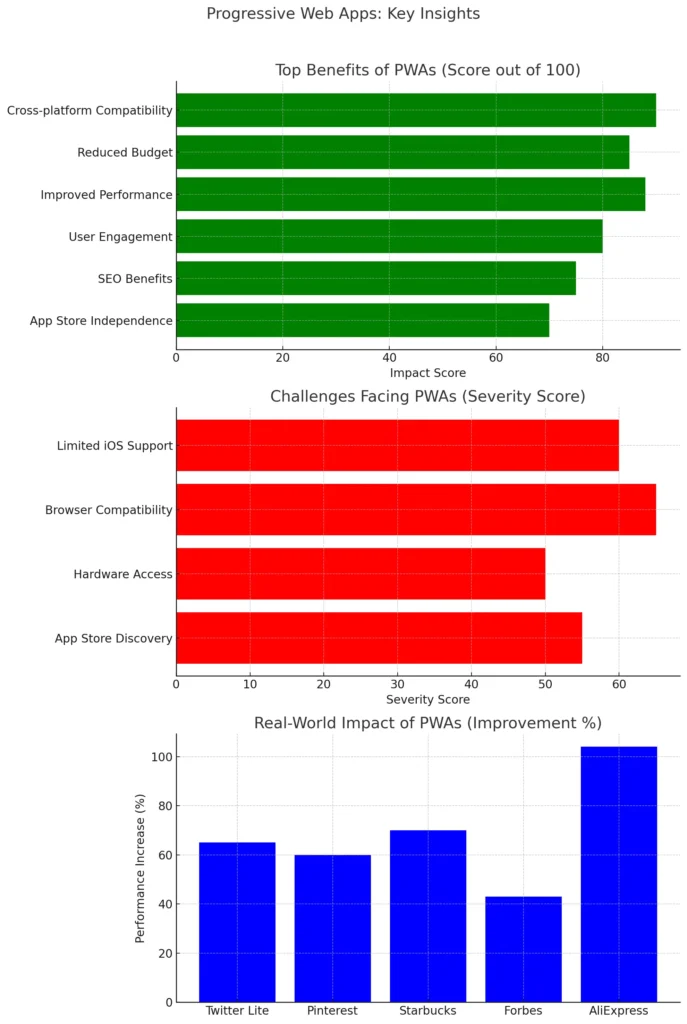A Progressive Web App (PWA) uses current web tools to offer a similar experience to regular mobile apps. Just like regular websites, PWAs are created with HTML, CSS, and JavaScript, yet they have additional features to make using them more engaging, such as service workers, push notifications, and working offline.
Because they follow progressive enhancement, these apps can serve every user, whether they use Firefox, Chrome, or another browser. Therefore, they behave normally on older browsers but add new features when used on modern web browsers.
The Main Elements in PWAs
Understanding the fundamental technologies used in PWAs is necessary.
1. Service Workers
Any scripts labeled service workers run in the web app’s background, separate from the browser’s main thread. Thanks to these technologies, we get automatic background updates, the option to view information without an internet connection, and notification messages. Thanks to service workers, PWAs can operate offline by providing content from their storage instead of network requests.
2. App manifest
The web app manifest is a JSON file used to identify the app by name, its icons, colors, along its orientation while on a screen. Using a manifest, the browser understands the app’s appearance and behavior after it is installed on a device.
3. HTTPS
Running service workers within a secure context ensures that PWAs work without issues. HTTPS makes it harder for someone to access or change data that is being transferred.
4. The design of Application Shell.
In most situations, the application shell architecture loads and stores essential parts of the UI the first time and reuses them as necessary. With this, users enjoy enhanced performance and a better experience.
What Are PWAs’ Key Features
PWAs come with features that allow them to operate much like web apps on the internet and like mobile apps for users.

1. Installable
Adding a PWA to a home screen does not require a visit to an app store. After installation, they appear in their own window, which makes the game more engaging.
2. Offline Support
PWAs benefit from service workers, which allow them to work and access assets even when the network is quiet or not available.
3. Responsive Design
You can access a PWA on any device, since they are made to fit screens of all sizes.
4. Push Notifications
Sending real-time push notifications to users through PWAs can help in attracting and retaining more people.
5. The website loads swiftly
Because of caching, PWAs can load fast, despite problems with the network.
6. Secure
Information is transferred safely and privately to users because PWAs are served over HTTPS.
7. App-like Feel
Users get a consistent feeling of an app due to the way PWAs have app-like navigation, animations, and gestures.
Reasons to use PWAs
Both developers and users can benefit greatly from PWAs.
1. Cross-platform Compatibility
Because PWAs run on any platform, developers typically do not need to create special versions for iOS, Android, and the web.
2. Reduced budget for building the app
Building and maintaining only one app is more cost-effective for businesses than managing several native apps.
3. Improved Performance
When pages load faster and are properly cached, you can expect fewer bounces from visitors.
4. More People Being Engaged
Push notifications, being able to use the app without an internet connection, and setting it as the home screen help encourage users to keep using it.
5. SEO Benefits
Because PWAs are built using the web, they can be found by search engines and are thus easier to discover.
6. No need for Apple’s official App Store
Since apps are accessed through a web browser, developers manage when updates are rolled out.

Barriers and Obstacles
Though using PWAs can be rewarding, they still face a few challenges:
1. Only a portion of iOS is supported.
Push notifications and background sync are more limited in Apple’s Progressive Web Apps than what is offered on Android.
2. Browser Compatibility
Older web browsers might not run every feature of PWAs, but the number of browsers with support is increasing.
3. Hardware Access
Unlike native applications, PWAs can only make use of a few hardware components, for example, Bluetooth and sensors.
4. Being easy to discover in the App Store
Being found through stores is a challenge for PWAs, so their reach is likely narrower than for native apps.
PWAs are being used in many real-world applications.
Many of the biggest companies in the industry are turning to PWAs to enhance what users go through and help achieve their goals:
1. Twitter Lite
The Twitter Lite PWA gives people in places with poor internet service a more efficient and quicker way to use Twitter. It reduced the number of people who left the site by 20% and also increased the number of pages each visitor viewed by 65%.
2. Pinterest
Introducing the PWA brought a 60% rise in users’ main interactions and led to a 44% increase in user-created advertising earnings.
3. Starbucks
Customers using the Starbucks PWA can view the menu, personalize their drinks, and add things to their carts even without an internet connection. Since a PWA is far smaller than its native alternative, it reaches more users.
4. Forbes
Forbes shifted towards a Progressive Web App to make its mobile website faster. Because pages loaded so quickly, each user visited 43% more pages on the site.
5. AliExpress
As a result of adopting PWAs, the percentage of first-time users who converted went up by 104%.
How and when can a PWA be used?
PWAs are suited for situations in which:
- You wish to offer the same app to users on many platforms.
- A lot of users may try to use the app on networks that are not strong or reliable.
- You want to pour fewer resources into development while continuing to deliver a remarkable UX.
- You should make an effort to bypass the limitations of distributing your app in app stores.
Best Tips for Developing a PWA
For a PWA to be successful, developers should adhere to the best ideas in the field.

- Check that the website can be used on all devices.
- Ensure that the website is protected using an HTTPS certificate.
- Come up with a reliable plan for caching and using your site when offline.
- Prepare a detailed description of the web app you are creating.
- Make sure your JavaScript files are optimized and reduced in size.
- Only activate push notifications when it’s necessary.
- Continuously test your code on several gadgets and internet browsers.
The Future of PWAs
PWAs continue to gain traction as web standards evolve and browser support improves. With increased backing from Google, Microsoft, and other tech giants, PWAs are becoming a mainstream solution for building modern web experiences.
Emerging standards and APIs, such as Web Bluetooth, Web Payments, and advanced background processing, are further expanding what PWAs can do.
As businesses look for scalable, cost-effective ways to reach users, PWAs offer a compelling alternative to native app development. While they may not completely replace native apps in all scenarios, their versatility and power make them an essential tool in any developer’s toolkit.
Conclusion
Progressive Web Apps represent a significant evolution in web development, combining the flexibility of the web with the rich user experiences of native apps. By leveraging modern web technologies, PWAs offer improved performance, offline access, and greater user engagement. For developers and businesses aiming to provide seamless, high-quality experiences across devices and networks, PWAs are a forward-thinking solution that promises both innovation and impact.





